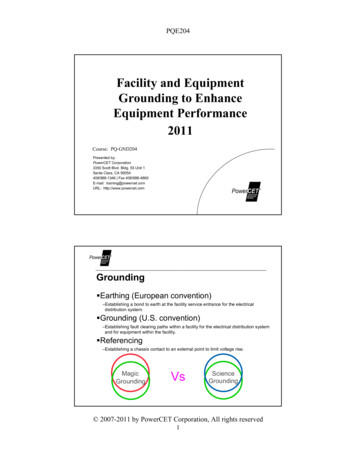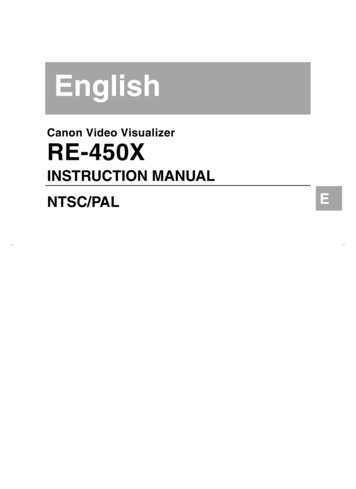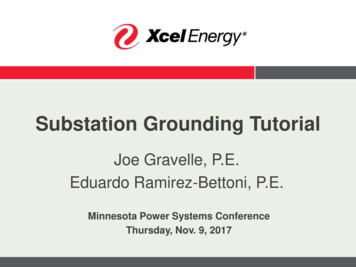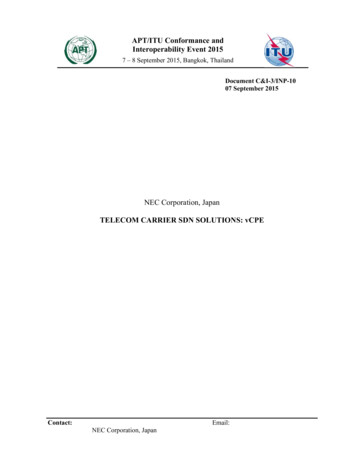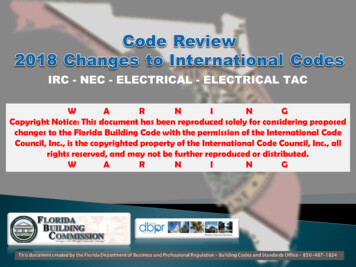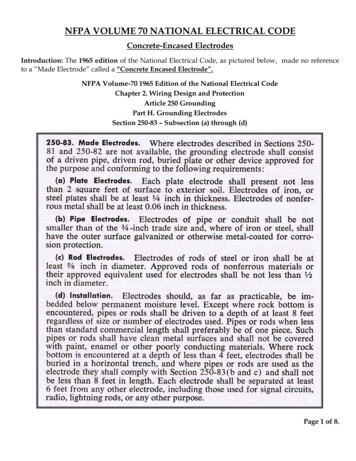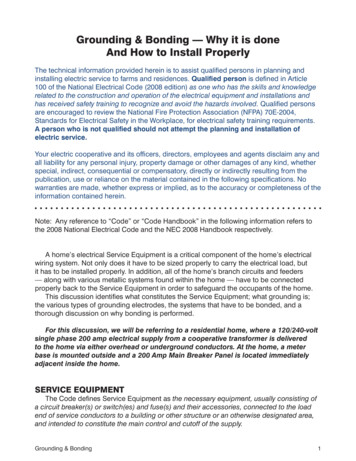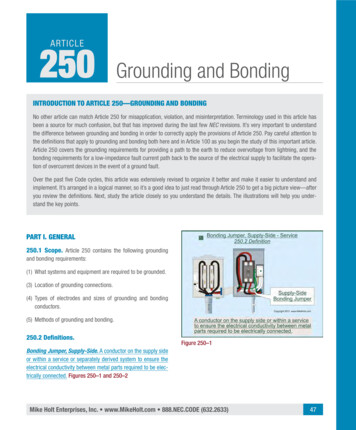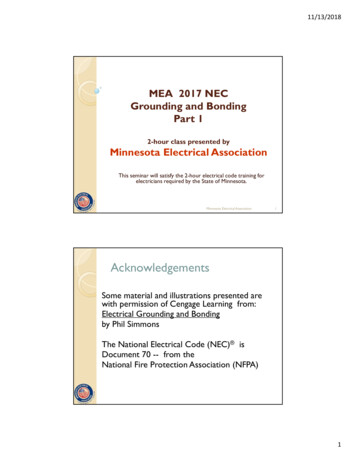
Transcription
11/13/2018MEA 2017 NECGrounding and BondingPart 12-hour class presented byMinnesota Electrical AssociationThis seminar will satisfy the 2-hour electrical code training forelectricians required by the State of Minnesota.Minnesota Electrical Association1AcknowledgementsSome material and illustrations presented arewith permission of Cengage Learning from:Electrical Grounding and Bondingby Phil SimmonsThe National Electrical Code (NEC) isDocument 70 -- from theNational Fire Protection Association (NFPA)1
11/13/2018Objectives Using accepted definitions of terms applicable togrounding & bondingProvide a low-impedance path of propercapacity to ensure the operation of overcurrentprotective devicesVarious components of the grounding & bondingsystemElectric shock hazards & effect of electricity onthe human bodyGrounding practices3Grounding and bonding concepts The subject of grounding and bonding ofelectrical systems is often misunderstood. Are grounded systems safer than ungrounded? Many systems are required to be grounded Several circuits are not permitted to begrounded The NEC has created rules to comply.42
11/13/2018Speaking the Same Language Inconsistent use of terms related togrounding and bonding is common and canresult in misunderstandings. Do terms “grounded” and “bonded” meanthe same thing? Are they interchangeable?5Speaking the Same LanguageIs a receptacle on the 17th floor of abuilding still “grounded?” Definition of “Grounded” is:“Connected (connecting) to ground orto a conductive body that extends theground connection.” Understanding definitions is essential toproper application of the rules related togrounding and bonding. 63
11/13/2018Definitions Understanding of definitions is essential tounderstanding grounding and bonding Some definitions may have changed fromthe previous edition of the NEC Many rules in the NEC have become moreprescriptive to rely less on defined terms7Art. 100: GroundNEC Def. of Ground:“The earth.” The earth consists ofmany types of soil Soil resistance isdetermined largely byits content ofelectrolytes whichconsist of moisture,minerals and dissolvedsalts84
11/13/2018Ground- Earth- characteristics Soil resistance varies from an average of approximately2,000 ohm-centimeters (equiv: ohms/ distance) forashes, cinders, brine or waste to 94,000 ohmcentimeters for gravel, sand, and stones with little clayor loam - highly resistive, little moisture content The earth’s ability to carry current varies widelydepending on temp and moisture content In the NEC, connections to earth are notpermitted for the purpose of carrying normalcurrent9Terms Related to the Definition of“Ground” What is the electrical system? Source--- Typically from the electric utility. Often from the source of a separately derived system The purposes of grounding electrical systems iscovered at 250.4(A)(2) – E.g., to limit the voltageto ground on non-current carrying conductivematerial The purposes of grounding equipment forungrounded systems is covered at 250.4(B)(1):Similar to A2 but for accidental contact or lightning105
11/13/2018NEC Art 250one-lineCopyright NFPA11Art. 100, Grounded (Grounding) Def. Grounded (Grounding ) “Connected (connecting) toground or to a conducting body that extends the groundconnection”Connection to ground is accomplished by means of arecognized grounding electrode (system). See Parts II andIII of Article 250It is vital to provide an effective ground-fault current pathdefined and described in Article 250.4(A)(5)Grounded objects such as metal conduit, cables withmetallic sheaths and structural metal may “extend theearth connection.”126
11/13/2018Copyright Cengage Learning13Bonding Jumpers ID Main bonding jumpersSystem bonding jumpersSupply-side bonding jumpers on supply side ofthe service or a separately derived systemEquipment bonding jumpers on the load side ofthe serviceBonding jumpers to metal piping systems and tostructural metal frames of buildings147
11/13/2018Copyright Cengage Learning15One line grounding168
11/13/2018Grounded (Grounding)The phrase “a conductive body that extends theearth connection” is not defined in the NEC A conductive element such as conduit, cable orwire that extends from the point where an earthconnection is made at one or more groundingelectrodes to another point on the electricalsystem where a switchboard, panelboard, junctionor pull box or a grounding receptacle is properlyconnected “extends the earth connection” 17Copyright Cengage Learning189
11/13/2018Grounded (Grounding) Some grounding electrodes also “extend the earthconnection” more precisely grounding conductors Structural metal often extends many stories above thepoint where it makes an earth connection or isconnected to a grounding electrode system See 250.52 (A) (2)New electrode information Metal water pipes are recognized in certainoccupancies for connection purposes throughout abuilding or structure See 250.30 for the rules on grounding separatelyderived systems19Grounded, ImproperlyEquipment can be “grounded” but not bein compliance with NEC rules “Grounded (Grounding)” meansconnected (connecting) to earth or tosome conducting body that extends theground connection (low impedance) Equipment grounding must be incompliance with the “Effective ground faultpath rules” in 250.4(A)(5) and 250.4(B)(4) 2010
11/13/2018Copyright Cengage Learning21Art. 100, Bonded (Bonding) Def. Bonded: “Connected to establishelectrical continuity and conductivity” In its simplest form, the definition meansthe conductor and connections to connectequipment together and to provide acomplete path for current to flow Bonding ensures conductivity aroundsuspect connections2211
11/13/2018Copyright Cengage Learning23Bonded (Bonding) Conduit, or equipment groundingconductor in Type MC or other wiringmethods, are permitted to be used to bond(connect) enclosures together. The function of equipment grounding andbonding become inseparable2412
11/13/2018Copyright Cengage Learning25Art. 100, Bonding Jumper Def. Bonding conductor or jumper: “A reliableconductor to ensure the required electricalconductivity between metal parts required tobe electrically connected.” Usually a wire-type conductor used toconnect parts that are required to beelectrically continuous Specific sizes are given for application2613
11/13/2018Equipment Bonding/ Grounding Jumpers Permitted to beinstalled outsideraceway or cable If installed outsideconduit, generallylimited to not morethan 6 ft (1.8 m) Longer lengthspermitted for polesCopyright Cengage Learning27Equipment Bonding Jumper Def. Equipment bondingjumper: The connectionsbetween two or moreportions of the equipmentgrounding conductor.Where a metal conduit ortubing serves as bondingmeans, a single looseconnection will impair thefault path.This can result in shockhazard.Copyright Cengage Learning2814
11/13/2018Main Bonding Jumper (Art 100) Def. Bonding jumper, Main : The connection between thegrounded circuit conductor and the equipment groundingconductor at the service. Size: See 250.24(B) - 250.28 - 250.28(D)1 –250.102(C)(1) Must be large enough so it does not melt while carrying faultcurrent - 250.102(C)(1) Permitted to be a wire, a bus, or a screw - 250.8Identical in function to “system bonding jumper” Provides return path for fault current Many rules on the Main Bonding Jumper are in 250.2829Copyright Cengage Learning3015
11/13/2018Supply-Side Bonding Jumper (250.2) Def. Bonding Jumper, Supply-Side. A conductor installed onthe supply side of a service or within a service equipmentenclosure(s), or for a separately derived system, thatensures the required electrical conductivity between metalparts required to be electrically connected. [250.30(A)(2) forseparately derived] Used for bonding raceways, and enclosurescontaining service conductorsAlso used to ensure bonding for metal enclosures forseparately derived systemsBonding jumper sized from Table 250.102(C)(1) on thesize of the ungrounded service conductor or the derivedungrounded conductor of separately derived system 31Copyright Cengage Learning3216
11/13/2018System Bonding Jumper (Art 100) Def. Bonding Jumper, System. The connection between thegrounded circuit conductor and the supply-side bondingjumper, or the equipment grounding conductor, or both,at a separately derived system. Identical in function to “main bonding jumper” for service Must be large enough so it does not melt while carryingfault current Permitted to be a wire, a bus, or a screw Provides return path for fault current33Copyright Cengage Learning3417
11/13/2018Art. 100, Grounded, Solidly Def. Grounded, Solidly. Connected toground without inserting any resistor orimpedance device Considered “solidly grounded” if a resistor orimpedance device such as an inductor are notinserted in the connection of the system orequipment to the grounding electrode High impedance grounded neutral systems arecovered in 250.3635Grounded, Solidly“Connected toground withoutinserting anyresistor orimpedance device.”(Article 100)Copyright Cengage Learning3618
11/13/2018Art. 100, Grounded Conductor Def. Grounded conductor: “A system or circuitconductor that is intentionally grounded.” A broad term that includes both neutralconductors and grounded conductors- that arenot a neutral All neutral conductors are grounded conductorsbut not all grounded conductors are neutralconductors (See the definition of “Neutral” and“Neutral Point”)37Definitions Neutral Conductor: The conductor connected tothe neutral point of a system that is intended tocarry current under normal conditionsNeutral Point: The common point on a wyeconnection in a polyphase system or the midpointfa single phase, 3-wiresystem, or the midpoint of asingle-phase portion of a 3-phase delta system, orthe midpoint of a 3-wire, DC current system. “Informational Note: At the neutral point of thesystem, the vectoral sum of the nominal voltagesfrom all other phases within the system thatutilize the neutral, with respect to the neutralpoint, is a zero potential.” 19
11/13/2018Grounded Conductor“A system orcircuit conductorthat is intentionallygrounded.” (Article100)Copyright Cengage Learning39Art. 100, Equipment GroundingConductorDef. Grounding Conductor, Equipment:(EGC) “The conductive path(s) thatprovides a ground-fault current path andconnects normally non–current-carryingmetal parts of equipment together and tothe system grounded conductor or to thegrounding electrode conductor, or both.”4020
11/13/2018Copyright Cengage LearningEquipment Grounding Conductor Conductive path is provided by the equipmentgrounding conductor Paths recognized include a wire or bus, metallicraceways and metallic cable sheaths “Normally non-current-carrying metal partsof equipment ” Equipment grounding conductors do not normallycarry current Neutral conductors do carry current under normalconditions4221
11/13/2018Equipment Grounding Conductor “Together” in definition indicates theequipment grounding conductor performsa bonding function. Informational Note No. 1: It is recognized theequipment grounding conductor also performsbonding. Informational Note No. 2: See 250.118 for a listof acceptable equipment grounding conductors.43Grounding ElectrodeDescriptions of grounding electrodes permitted tobe used are in 250.52(A) 8 items See NEC page 112 Items NOT permitted to be used as Groundingelectrodes 250.52(B) 3 items See NEC page 113 Grounding electrodes are never used toprovide a fault-current path Are used to make an earth connection4422
11/13/2018Art. 100, Grounding ElectrodeDefinitionGrounding Electrode:“A conducting objectthrough which a directconnection to earth isestablished.”45Grounding Electrode Conductor“A conductor usedto connect thesystem groundedconductor or theequipment to agrounding electrode,or to a point on thegrounding electrodesystem.”Copyright Cengage Learning4623
11/13/2018Grounding Electrode Conductor Size in compliance with 250.66 (both Tableand Section) Install under the rules of 250.64(A-E)NEC P. 114 Connect in accordance with 250.8(Connection methods) and 250.70 (Methodsof bonding and grounding conductors toelectrodes)47Art. 100, Intersystem BondingTermination Def: Intersystem Bonding Termination: “A devicethat provides a means for connecting intersystembonding conductors for communicationssystems to the grounding electrode system.” Provides common location for connectingbonding conductors for communications systems. Common bonding helps prevent flashover due toelevated voltage events.4824
11/13/2018Art. 100, Intersystem BondingTerminationIntersystem bonding example bondingCopyright Cengage Learning49NEC Art. 100, Neutral ConductorDef. Neutral Conductor: “The conductorconnected to the neutral point of a system thatis intended to carry current under normalconditions.”This term is used in conjunction with thedefinition of “neutral point.”Differs from an equipment grounding conductorin that it is intended to carry current undernormal conditions.Neutrals are also grounded conductors.5025
11/13/2018Neutral PointTypical electrical systems that have a neutralconductor include: 120/240, 1-phase, 3-wire120/240-volt, 3-phase, 4-wire (delta-connected)208Y/120-volt, 3-phase, 4-wire (wye-connected)480Y/277-volt, 3-phase, 4-wire (wye-connected)51Neutral Point and Neutral ConductorCopyright Cengage Learning5226
11/13/2018Neutral Point and Neutral ConductorCopyright Cengage Learning53NEC Art 100: Separately DerivedSystemDef. Separately Derived System: “An electricalsource, other than a service, having no directconnection(s) to circuit conductors of any otherelectrical source other than those established bygrounding and bonding connections.”5427
11/13/2018Separately Derived System Is a premises wiring system Is NOT directly supplied by the electric utility Transformers are “equipment other than aservice.” may provide separately derivedsystem Path through the earth, metal enclosures,metallic raceways and equipment groundingconductors do not constitute a “directelectrical connection.”55Separately Derived SystemA premises wiringsystem whose poweris derived from asource of electricenergy or equipmentother than theservice. Suchsystems have Copyright Cengage Learning5628
11/13/2018Separately Derived SystemCopyright Cengage Learning57Copyright Cengage Learning5829
11/13/2018Fuel Cells and Solar PhotovoltaicSystemsProduce direct current Inverter and other conversion equipmentcreate alternating current If grounded system conductor connectsdirectly to inverter neutral conductor, it isnot a separately derived system 59The current path The information in 250.4 (A) (5) provides importantconcepts regarding an effective ground-fault return path Low-impedance path facilitates the operation ofovercurrent devices Removing the fault quickly reduces the thermal andmagnetic stresses on equipment and conductors Most overcurrent devices are “inverse time” (thegreater the current, the faster the operation of theovercurrent device) so high current are interrupted inless time6030
11/13/2018Art 100 Ground-Fault Current Path Def. Ground-Fault Current Path. An electricallyconductive path from the point of a ground fault on awiring system through normally non–currentcarrying conductors, equipment, or the earth, - to theelectrical supply source. “Facilitates the operation of the overcurrentdevice or ground fault detectors on a highimpedance grounded systems.”61Copyright Cengage Learning31
11/13/2018Effective Ground-Fault Current PathIntentionally constructed Deliberate steps taken to create the path Properly connect all components Carries fault-current to facilitate operationof overcurrent device or ground-faultdetector 63Effective Ground-Fault Current PathLow-impedance “Impedance” is totalopposition to currentflow in ac circuits All circuit conductorsmust be installed inclose proximity toreduce impedance See 300.3(B) –(conductors of thesame circuit) Copyright Cengage LearningAdds to impedance6432
11/13/2018Effective Ground-Fault Current PathAll circuitconductors must beinstalled in closeproximity somagnetic lines offorce can cancelThis helps ensure alow-impedancefault-current path Amps ofallAmps ofoneAll currents measuredtogether- should be zeroCopyright Cengage Learning65Rating and Operation of OvercurrentDevices Tested to carry full load current indefinitelyNEC requires circuit to be no more than 80percent of rated current unless overcurrentdevice is rated for 100 percent operationTime-current curves should be consulted todetermine the amount of current required toreach the instantaneous trip modeImpedance of fault current path must be lowenough to facilitate operation of OCP6633
11/13/2018Time current curves67Effective Ground-Fault Current Path Continuous and reliableComponents and connections are intended tolast for the life of the installationUnless monitored, equipment grounding pathcan be incomplete without indication (loosefittings)Does not carry current in normaloperationOften, a break in the Path is discovered byelectric shock after faulted equipmentbecomes energized6834
11/13/2018Path Through the EarthThe path through the earth can be in parallel withground-fault current return path where more thanone connection to earth exists. The earth is not considered an “effectiveground-fault current path”. Connections are made to earth for otherpurposes, but never to carry fault current. Path only through the earth will result in electricalequipment presenting a dangerous electric shockhazard. 69Copyright Cengage Learning7035
11/13/2018Parallel Conductors 310.10 (H)Parallel conductor installations to be made underrules in 310.10(H) Two or more conductors are connectedtogether at each end to create a conductive pathwith increased capacity. Concept is to have all conductors share currentequally Equipment grounding conductors are installed inparallel under rules of 250.122(F) New parts1-2 71250.122 (F) Conductors in parallel (F)(1)(a) If conductors are installed inparallel in the same raceway or cable tray, asingle wire type conductor shall bepermitted as the equipment ground. - basedon 250.122 and overcurrent protection(b) If wire type conductors are installed inmultiple raceways, wire type groundingconductors where used shall be installed inparallel in each raceway based on 250.122and the overcurrent protection36
11/13/2018250.122 (F) Conductors in parallel(F)(2)(a) If multi-conductor cables areinstalled in parallel the groundingconductors in each cable shall beconnected in parallel (b) If multi-conductor cables are installedin parallel in the same raceway, a singlewire-type grounding conductor with thecable grounding wires shall be permittedto be connected together Copyright Cengage Learning7437
11/13/2018Parallel Conductor Grounding 250.122 (F) (1)Parallel Cable grounding 250.122(F)(2)38
11/13/2018Underground Parallel SetsIn nonmetallic racewaysrun underground,permitted to haveisolated phaseinstallations Conductors line upwith bussing in largerinstallations Caution about wirebending space rules Copyright Cengage Learning77Underground Parallel Sets Avoid heatingsurrounding metalby inductionCut a slot betweenconduit entries inmagnetic enclosuresNon-ferrous platecan be installed forentriesCopyright Cengage Learning7839
11/13/2018Art 100 GroundFaultDef. Ground Fault: Anunintentional, electricallyconductive connectionbetween anungrounded conductorof an electrical circuitand the normally noncurrent-carryingconductors, metallicenclosures, metallicraceways, metallicequipment or earth.79Copyright Cengage LearningGround Fault on Grounded ConductorA grounded conductor (may be a neutral) isgrounded at the source and at the service Some separately derived systems are required tobe grounded The grounded system conductor is generallyrequired to be isolated (insulated) downstreamfrom the service and source of a separatelyderived system. Improper grounding of grounded conductor cancause malfunction or improper system operation 8040
11/13/2018Ground Fault on ConductorsGround-fault circuit-interrupters: GFCI monitors current flowing to and from the load Listed Class A device not permitted to trip at less than4 mA, must trip at 6 mA or greater imbalance ofcurrent A grounded conductor that is grounded beyond theGFCI device will result in a parallel path for neutralcurrent This will usually result in “nuisance trips”81Copyright Cengage Learning8241
11/13/2018Factors That Determine Severity ofElectric ShockThe amount of current that flows The path the current takes through thebody The length of time the current flows 83Human Body CircuitNote that the resistanceof skin can varysignificantly from oneperson to another andfrom one time to another.Skin that is wet or moistmay have much lowerresistance. Skin that is drymay have much higherresistance.Copyright Cengage Learning8442
11/13/2018Current through 1100 Ohm HumanCircuitCurrent (Amperes or mA)1100 Ohms(Dry Skin)300 Ohms(Wet CIRCUIT VOLTAGE48085Dangerous Electric CurrentsCurrent mA, 60 HzMENWOMENSlight sensation on hand0.40.3Perception of “let-go” threshold, median1.10.7Shock, not painful, and no loss ofmuscular control1.81.2Painful shock – muscular control lost byhalf of participants96Painful shock – “let-go” threshold, median1610.5Painful and severe shock – breathingdifficult, muscular control lost2315EFFECT(S)8643
11/13/2018Reducing Shock HazardsProper grounding and bonding can reducelikelihood of electric shock Electric shock when current passesthrough the chest can result in ventricularfibrillation Death can occur if condition is notcorrected 87Ground Fault on ConductorsGround-fault protection of equipment(GFPE) required for a grounded systemswhere: The voltage to ground is more than 150 volts The phase-to-phase voltage is 600 volts or less For overcurrent devices rated 1000 amperesor more 230.95 for services; 215.10 for feeders; 210.13Branch Circuits: 240.13 for buildingdisconnecting means8844
11/13/2018Arc Fault on ConductorsArc-fault circuit interrupters (AFCI) Intended to provide protection from theeffects of arcing faults by recognizingcharacteristics unique to arcing by deenergizing the circuit when an undesirable arcis detectedNeutral fault to grounded enclosure, racewayor equipment on load side of AFCI device canresult in unintended operation89Short CircuitAn abnormalconnection ofrelatively lowimpedance, whethermade accidentally orintentionally,between two pointsof different potentialon any circuit.Two normalcurrent carrying90Copyright Cengage Learning45
11/13/2018Ground-Fault Current Path“An electrically conductive path from thepoint of a ground fault on a wiring systemthrough normally non-current-carryingconductors, equipment, or the earth to theelectrical supply source.”91Ground-Fault Current Path“Informational Note:Examples of ground-fault current paths couldconsist of any combination of equipment groundingconductors, metallic raceways, metallic cablesheaths, electrical equipment, and any otherelectrically conductive material such as metal waterand gas piping, steel framing members, stucco mesh,metal ducting, reinforcing steel, shields ofcommunications cables, and the earth itself.”9246
11/13/2018Copyright Cengage Learning93250.3 Application of Other ArticlesTable 250.3 covers additional groundingrequirements that are found in otherarticles The rules in NEC Chapters 5, 6 and 7 canamend or supplement the rules inChapters 1 through 4 Examples include: Articles 547 (agriculturalbuildings), 600 (signs) and 517 (health carefacilities) 9447
11/13/2018250.4 General Requirements forGrounding and BondingIncludes “performance requirements” results “Prescriptive requirements” – how to dorequirements-- are provided in theremainder of Article 250 250.4(A)(1) gives example of performancerule. No specific measurable requirements areprovided 95Copyright Cengage Learning9648
11/13/2018250.4(A) Grounded Systems 250.4(A) provides “performance” rules forgrounded systems 250.4(B) provides “performance” rules forungrounded systems97250.4(A)(1) Electrical SystemGroundingElectrical systems that are grounded arerequired to be connected to earth in a waythat will limit the voltage imposed by lightning, line surges, or unintentional contact with higher-voltage linesand will stabilize the voltage of the system to earthduring normal operation.9849
11/13/2018Copyright Cengage Learning99Copyright Cengage Learning50
11/13/2018250.4(A)(2) Grounding of ElectricalEquipment“Normally non–currentcarrying conductivematerials enclosing electricalconductors or equipment,or forming part of suchequipment, are required tobe connected to earth tolimit the voltage to groundon these materials.”Copyright Cengage Learning101250.4(A)(2) Grounding of ElectricalEquipmentA shock orelectrocution hazard canoccur if there is a breakin the ground-faultreturn pathCopyright Cengage Learning10251
11/13/2018250.4(A)(3) Bonding of ElectricalEquipmentNormally non-current-carrying conductivematerials enclosing electrical conductors orequipment, or forming part of suchequipment, are required to be connectedtogether and to the electrical supply sourcein a manner that establishes an effectiveground-fault current path103250.4(A)(3) Bonding of Electrical Equipment In its simplest form,bonding completes apath through whichcurrent can flowBonding also keepsconnected parts at thesame potentialEliminates shock hazardCopyright Cengage Learning10452
11/13/2018Bonding Jumpers Main bonding jumpersSystem bonding jumpersSupply-side bonding jumpers on supply side ofthe service or a separately derived systemEquipment bonding jumpers on the load side ofthe serviceBonding jumpers to metal piping systems and tostructural metal frames of buildings105Copyright Cengage Learning10653
11/13/2018Bonding Jumpers Required Loose locknut connectionsFor conduit or cable connections to paintedenclosuresService equipment enclosuresAround concentric and eccentric knockoutsAround knockout reducing washers (ifsuspect connection)Hazardous (classified) locationsOver 250 volts-to-ground107250.4(A)(4) Bonding of ElectricallyConductive MaterialsNormally non-currentcarrying electricallyconductive materials thatare likely to becomeenergized are required tobe connected togetherand to the electrical supplysource to form effectiveground-fault current pathCopyright Cengage Learning10854
11/13/2018250.4(A)(5) Effective Ground-FaultCurrent PathElectrical equipment and other electricallyconductive material likely to becomeenergized to be connected (bonded) in amanner that is:1. Reliable2. Provides a circuit of low impedance3. Facilitates the operation of theovercurrent device or ground detectionThe conductor must safely carry themaximum fault current likely to be imposed109250.4(A)(5) Effective Ground-FaultCurrent Path Metal conduitbecomes currentcarrying conductorwhen returning faultcurrent to sourceSingle loose locknutor loose or brokenfitting can result inbreak in fault pathCopyright Cengage Learning11055
11/13/2018250.4(A)(5) Effective Ground-FaultCurrent Path Ohmic value of lowimpedance path notspecified in NECKeep all circuitconductors, includingungrounded, groundedand equipmentgrounding conductorstogetherCopyright Cengage Learning111Operating Characteristics ofOvercurrent DevicesMost overcurrent devices such as circuitbreakers and fuses are “inverse-time” Manufacturers furnish time-current curvesfor the overcurrent devices theymanufacture 11256
11/13/2018Operating Characteristics of CircuitBreakersVertical line in time-current curverepresents trip time in seconds Curved portion represents time-delaymode of circuit breaker Width of curve represents the permittedrange of time-delay and instantaneous tripoperation 113Copyright Cengage Learning11457
11/13/2018Operating Characteristics of Fuses Time in seconds are onthe leftRMS Symmetrical currentacross the bottom60A fuse will clear inabout 0.1 seconds for400-ampere fault115Copyright Cengage LearningKeep All Circuit Conductors TogetherRequired in 250.134 and 300.3(B)(1)through (4) Low impedance of fault return path willensure adequate current will flow toprovide for rapid operation of overcurrentdevice See “White Paper” report of R.K.Kaufmann. 11658
11/13/2018250.4(A)(5) Effective Ground-FaultCurrent PathThe conductor must be capable of safelycarrying the maximum fault current likelyto be imposed on it Table 250.102C1 & Notes used on line sideof service Table 250.122 used on load side of serviceOvercurrent Fault-return path through the earth notpermitted as “sole” path 117250.4(A)(5) Effective Ground-FaultCurrent PathFault current will flow over all pathsavailable (including through the earth) The lowest impedance path will carry themost current The highest impedance path will carry thelowest current 11859
11/13/2018250.4(B) Ungrounded SystemsEven though the “system” is not grounded,the enclosures must be grounded andbonded119250.4(B)(1) Grounding ElectricalEquipment Non-current-carrying conductive materialsenclosing electrical conductors or equipmentor forming part of such equipment arerequired to be connected to earth in amanner that: Limits the voltage imposed by lightning orunintentional contact with higher-voltage linesand limits the voltage-to-ground on thesematerials.12060
11/13/2018250.4(B)(2) Bonding of ElectricalEquipmentNon-current-carrying conductive materialsenclosing electrical conductors or equipment,or forming part of such equipment, arerequired to be connected together and to thesupply system grounded equipment in amanner that creates a low-impedance pathfor g
the previous edition of the NEC Many rules in the NEC have become more prescriptive to rely less on defined terms 7 Art. 100: Ground NEC Def. of Ground: "The earth." The earth consists of many types of soil Soil resistance is determined largely by its content of electrolytes which consist of moisture, minerals and dissolved salts 8
